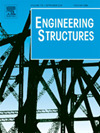Engineering Structures aims to provide a forum for a broad blend of scientific and technical papers to reflect the evolving needs of the structural engineer. Particularly welcome are contributions dealing with applications of structural engineering principles and theories in all areas of technology. The journal aspires to a broad and integrated coverage of the dynamic effects of wind, waves and earthquakes and of the modelling techniques whereby the structural response to these loadings may be computed. The scope of Engineering Structures encompasses, but is not restricted to, the following areas: infrastructure systems; ocean engineering; earthquake engineering; wind engineering; blast loading; structure - fluid - soil interaction; structural reliability/stability; life assessment/integrity; hazard assessment; random vibrations; engineering plasticity; computer-aided design; optimization; expert systems; experimental modelling; dynamic properties of materials; modelling of concrete/cracking; economics. The structures under consideration include: tall buildings; bridges; stadiums; commercial and public buildings; transmission towers; television masts; cooling towers; aerospace and marine vessels; plates and shells; foundations; suspension structures, smart structures; nuclear reactors; dams; pressure vessels; offshore rigs and drilling platforms; breakwaters and jetties; pipelines. The journal also publishes review articles pertaining to structural engineering as well as short communications and discussions. Engineering Structures also publishes book reviews and a diary on international events related to any aspect of structural engineering. Short reports on conferences, current research and letters to the Editor are also invited. All papers are reviewed by at least two referees.
